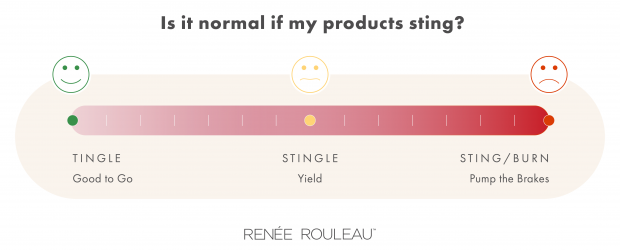
With so many skincare products these days containing potent and effective active ingredients, you might notice a tingling or stinging sensation when they’re applied. Is this a good thing? Does it mean the products are working effectively? Or, is this bad for your skin? In this post, I’ll explain how to know if the sensation you’re feeling from a skincare product is normal.
Which Sensations Are Considered Okay? How Much is Too Much?
A tingling or stinging sensation happens due to an inflammatory reaction to a skincare product. The face has nerve fibers that are close to the skin’s surface and when certain ingredients are applied, they can activate those nerve fibers. Since there are also blood vessels that are close to the surface of the skin, this inflammatory response can also lead to redness or a warm feeling.
In some cases, this is considered normal. In others, it means a product doesn’t agree with your skin and is a sign to stop using it.
But how do you know what’s okay and what isn’t? When I worked with clients at my spa and gave them professional chemical peels (which can get pretty spicy), I would always ask them to describe what they were feeling on a scale of 0-10. You can think of it in those terms, but since a 10 might be different for everyone, I like to break the sensations down into three basic categories: tingle, stingle, and sting/burn. Here’s the lowdown on each.
1. Tingle
A tingle is the mildest of the sensations. It’s a slight sensation that dissipates quickly (usually within a minute. You can feel something happening, but it resolves without any visible redness.
If all you feel is a tingle, you’re more than likely good to go. This is considered normal with certain ingredients, and it could also be an indication that your moisture barrier is a little delicate at the moment.
2. Stingle
This is a little more intense than the tingle level. It’s a mild prickling sensation that will go away on its own but may take up to two minutes to do so. The skin may look slightly pink and flushed or feel warm.
If you feel a stingle, you’re probably in the clear, but take stock before you keep going. Again, this is considered normal with certain products, and if it goes away within a couple of minutes, you’re fine. If it lasts longer or you’re feeling it frequently, it could mean your moisture barrier is compromised and needs some TLC. Those with sensitive skin (like Skin Types 3, 4, and 5) should pay extra attention to a stingle. It could mean you need to be a little careful with that product and use it less often or switch to a lower strength.
3. Sting/Burn
This is the most intense level and usually continues for a long while When skincare products sting, you’ll feel it a lot. If it continues for more than a minute, you’ll likely enter the burning-feeling phase (not good!). Stinging and burning are often accompanied by red or hot-feeling skin.
When a product causes this reaction at home, it’s a clear sign to stop and wash the product off. I would say the only exceptions are prescriptions or clinical-grade products given to you by a professional with specific usage instructions. The other time would be if you’re getting a professional treatment (like a chemical peel) from an esthetician or dermatologist. Since these usually work on deeper layers of the skin than at-home products, they tend to cause more intense sensations and are sometimes even designed to create a little damage to stimulate a healing response.
If this happens, here are 9 ways to soothe irritation fast.
When Is It Good to Feel a Sensation, Like Tingling or Stingling?
Whether or not you should be feeling a sensation ultimately hinges on the type of product you’re using. It’s normal to feel something if…
The product contains ingredients that lower your skin’s pH The product includes stimulating, energizing ingredients
Common Ingredients That Can Cause Tingling or Stingling
Exfoliating Acids
This includes AHAs like glycolic, lactic, and mandelic acids, BHAs like salicylic acid, and even PHAs. Some acids, like glycolic acid, have a smaller molecule size than others. This means they can penetrate more deeply and may be more likely to cause tingling. Learn more about the different types of exfoliating acids.
Exfoliating Enzymes
While these don’t work by altering the skin’s pH, it’s still considered normal for them to create a sensation. This includes ingredients like bromelain and papain
L-ascorbic Acid
This is one of the most common forms of vitamin C and can cause tingling or stingling thanks to its low pH. (This is why I prefer to formulate with gentler, yet equally effective, forms of vitamin C like tetrahexyldecyl ascorbate.)
Citric Acid
Like L-ascorbic acid, citric acid has a low pH and can cause a prickling sensation.
Stimulating Ingredients
These are ingredients meant to stimulate blood flow and revive dull skin, and they include peppermint or menthol, ginseng, and cyanocobalamin (vitamin B12).
*NOTE: If you use a product with one of these ingredients and you don’t feel a sensation, this does not mean the product isn’t working. Since everyone’s skin is different, everyone will experience these ingredients differently, but more on that later.
When is It Bad to Feel a Sensation?
For the most part, if you’re not using a product with any of the ingredients listed above, you don’t want to be feeling much of a sensation from your skincare products at all. Even a stingle could indicate that a product isn’t the right fit for you.
If you’re persistently feeling tingling or stingling without using the ingredients listed above, it could mean your skin’s moisture barrier is out of whack. When your barrier is compromised, products and ingredients that wouldn’t normally cause an issue can suddenly start to tingle or sting. This is because there are cracks in your protective barrier, which exposes your nerve endings and makes you feel super sensitive. It’s kind of like putting something on broken skin—it stings when it wouldn’t normally. You should still avoid ingredients that sting until you’ve restored your barrier, but it doesn’t mean you have to swear those products off for good! Just try adding them back in one by one once your skin is less sensitive. Learn more about possible reasons for a compromised barrier and how to fix it.
Aside from a damaged barrier, these are the most likely reasons a product will cause a negative sensation:
The product includes irritants, like high amounts of fragrance or essential oilsThe product includes high amounts of drying alcoholsThe product includes an ingredient to which you have an allergy or sensitivity
My Exfoliating Acid Serum Used to Sting, But Now It Doesn’t. Does This Mean It’s Not Working Anymore?
Many people will notice a stingle or a sting when they first start using exfoliating acids. This is completely expected. After a while, though, this can go away. Why? Because exfoliating acids actually improve lipid production to repair the skin barrier (cool, right?). As the barrier becomes stronger, less of a sting will be felt.
The problem is that some people associate stinging with efficacy. It’s the “no pain, no gain” mentality. If you keep trying to chase the sting by moving up to a higher percentage of acids, you could cause damage to your skin by keeping it in a state of inflammation. The goal is for you not to experience much of a tingle, stingle, or sting at all!
Bottom Line
Today, there are more advanced skincare products available than ever. Things once used by professionals are available to customers at home, so it’s more important than ever to monitor your skin and know when it’s telling you to pump the brakes. We don’t want to fall into the no pain no gain philosophy! It’s crucial to know your baseline and be able to make distinctions for yourself. A sensation isn’t automatically bad, but constantly putting your skin in a state of inflammation is a recipe for disaster.
Next, read about the four different types of skin sensitivity.
Celebrity Esthetician & Skincare ExpertAs an esthetician trained in cosmetic chemistry, Renée Rouleau has spent 30 years researching skin, educating her audience, and building an award-winning line of products. Her hands-on experience as an esthetician and trusted skin care expert has created a real-world solution — products that are formulated for nine different types of skin so your face will get exactly what it needs to look and feel its best. Trusted by celebrities, editors, bloggers, and skincare obsessives around the globe, her vast real-world knowledge and constant research are why Marie Claire calls her “the most passionate skin practitioner we know.”




